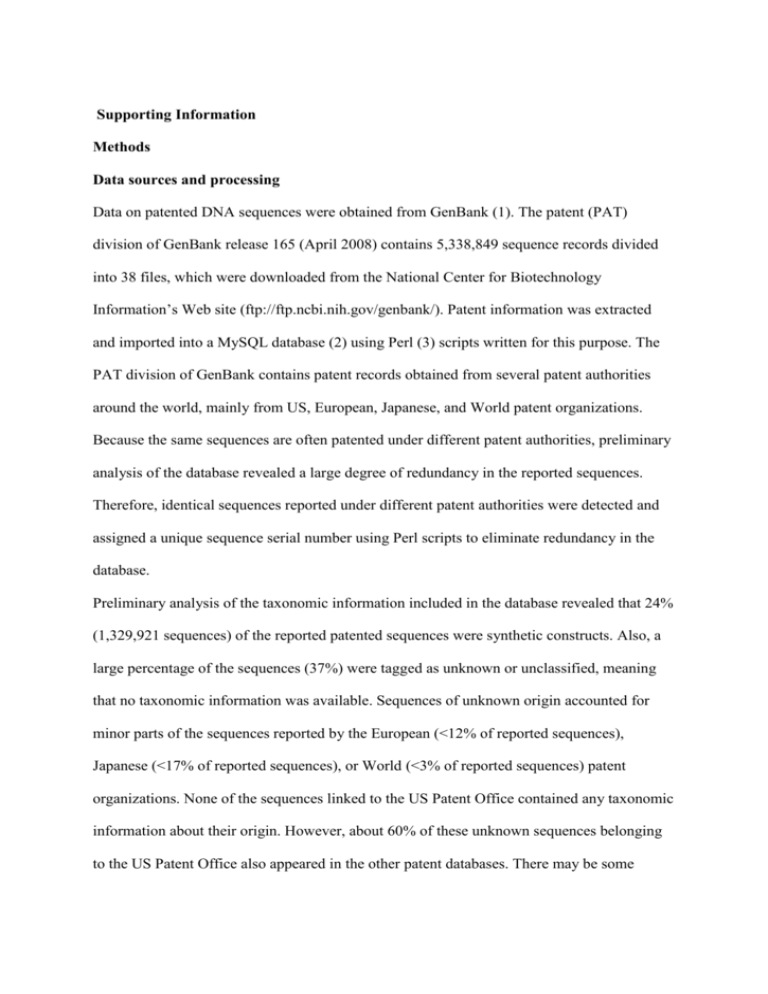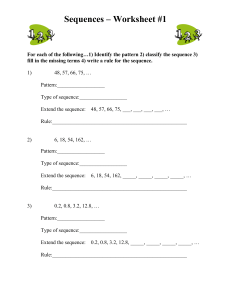Supporting Text_digit... - digital
advertisement

Supporting Information Methods Data sources and processing Data on patented DNA sequences were obtained from GenBank (1). The patent (PAT) division of GenBank release 165 (April 2008) contains 5,338,849 sequence records divided into 38 files, which were downloaded from the National Center for Biotechnology Information’s Web site (ftp://ftp.ncbi.nih.gov/genbank/). Patent information was extracted and imported into a MySQL database (2) using Perl (3) scripts written for this purpose. The PAT division of GenBank contains patent records obtained from several patent authorities around the world, mainly from US, European, Japanese, and World patent organizations. Because the same sequences are often patented under different patent authorities, preliminary analysis of the database revealed a large degree of redundancy in the reported sequences. Therefore, identical sequences reported under different patent authorities were detected and assigned a unique sequence serial number using Perl scripts to eliminate redundancy in the database. Preliminary analysis of the taxonomic information included in the database revealed that 24% (1,329,921 sequences) of the reported patented sequences were synthetic constructs. Also, a large percentage of the sequences (37%) were tagged as unknown or unclassified, meaning that no taxonomic information was available. Sequences of unknown origin accounted for minor parts of the sequences reported by the European (<12% of reported sequences), Japanese (<17% of reported sequences), or World (<3% of reported sequences) patent organizations. None of the sequences linked to the US Patent Office contained any taxonomic information about their origin. However, about 60% of these unknown sequences belonging to the US Patent Office also appeared in the other patent databases. There may be some additional sequences originating from marine organisms, and even some additional marine species among these patented sequences of unreported origin that cannot be identified. Moreover, the information contained in the PAT division of GenBank is by no means exhaustive; therefore, it is likely that additional marine sequences have been reported under other patent authorities not covered here. Thus, the impressive number of marine species having patented genes reported in this study represents only a minimum estimate of the actual bioprospecting activity in the oceans. The list of named species in the database was extracted, and the resulting name list was sorted and cleaned up manually to eliminate obvious spelling variants, typos, strain names or numbers, and other confounding information that could result in an overestimation of the number of named species. The list of clean unique species names was manually reviewed; marine organisms were identified and tagged in the database for subsequent analysis. Information on the number of previously undescribed marine natural products reported per year and the corresponding phylogenetic information about the sources were compiled from several annual reports (4–9). Because the taxonomic scheme used by GenBank (1) differs from that reported for natural products (4), the phylogenetic groups in Table S1 and in the trees in Fig. 2 and Fig. S1 have been chosen to match these two datasets and allow comparisons. Therefore, the chosen taxonomic affiliations do not represent a particular level (i.e., class, order) in a systematic hierarchy. The trees in figures 2 and fig S1 have been produced using the Interactive Tree of Life iTOL tool (10). References 1. Benson DA, Karsch-Mizrachi I, Lipman DJ, Ostell J, Wheeler DL (2008) GenBank. Nucl Acids Res 36:D25–D30. 2. MySQL 5.1. Available at http://dev.mysql.com/downloads. 3. Perl 5.8. Available at http://www.perl.org. 4. Blunt JW, et al. (2008) Marine natural products. Nat Prod Rep 25:35–94. 5. Blunt JW, et al. (2007) Marine natural products. Nat Prod Rep 24:31–86. 6. Blunt JW, Copp BR, Munro MHG, Northcote PT, Prinsep MR (2006) Marine natural products. Nat Prod Rep 23:26–78. 7. Blunt JW, Copp BR, Munro MHG, Northcote PT, Prinsep MR (2005) Marine natural products. Nat Prod Rep 22:15–61. 8. Blunt JW, Copp BR, Munro MH, Northcote PT, Prinsep MR (2004) Marine natural products. Nat Prod Rep 21:1–49. 9. Blunt JW, Copp BR, Munro MH, Northcote PT, Prinsep MR (2003) Marine natural products. Nat Prod Rep 20:1–48. 10. Letunic I, Bork P (2007) Interactive Tree Of Life (iTOL): An online tool for phylogenetic tree display and annotation. Bioinformatics 23:127–128. Figure legends Figure S1. Number of marine species subjected to different uses divided among different taxonomic groups. Table legends Table S1. Number of named marine species accounted as sources of patented genes, natural products, or domesticated for human consumption according to their taxonomic affiliation Supporting Table 1 Marine GenBank patents Taxonomic Group species* sequences* Unidentified_Archaea 0 18 Crenarchaeota 13 124 Euryarchaeota 27 422 Cyanobacteria 14 92 Proteobacteria 103 739 Firmicutes 22 240 Bacteroidetes 17 52 Thermotogales 3 161 Dehalococcoidetes 2 109 Other_bacteria 16 62 Alveolata 11 28 Fungi 4 48 Haptophyceae 3 17 Euamoebida 1 3 Annelida 2 40 Arthropoda 28 124 Chordata 94 927 Cnidaria 48 498 Ctenophora 2 3 Echinodermata 6 17 Mollusca 83 760 Porifera 2 16 Rhodophyta 6 20 Chlorophyta 6 45 Streptophyta 10 135 stramenopiles 32 223 Cryptomonadaceae 2 3 Euglenozoa 1 6 Bryozoa 0 0 Hemichordata 0 0 Nematoda 0 0 Platyhelminthes 0 0 Total 558 4932 *Unique sequences or named species (this paper) Marine natural products species** compounds** 0 0 0 0 0 0 118 602 29 3 0 0 1 4 0 0 0 0 0 0 0 0 19 48 0 0 0 0 40 49 57 23 356 977 642 3469 0 0 301 1074 445 1179 1185 6668 563 1548 287 315 0 0 643 1476 0 0 15 36 63 180 17 26 7 2 7 33 4795 17712 Domesticated species *** 0 0 0 1 0 0 0 0 0 0 0 0 0 0 0 39 121 1 0 4 84 0 11 2 0 5 0 0 0 0 0 0 268 ** Data from (S4) *** Data from (S10) The number of unique sequences or natural products described for each taxonomic group is also reported. *Patented genes. Unique sequences or named species (this paper). **Natural products. Data from Blunt JW, et al. (2008) Marine natural products. Nat Prod Rep 25:35–94. ***Domesticated for human consumption. Data from Duarte CM, Marbá N, Holmer M (2007) Ecology. Rapid domestication of marine species. Science 316:382–383 Supporting figure 1







